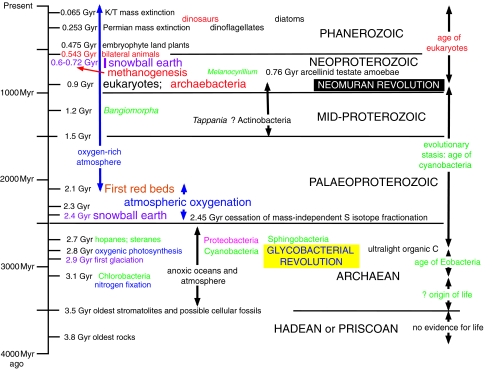Figure 8.
Key events in global history, integrating evidence from palaeontology and cell phylogeny. The Late Archaean and Late Proterozoic saw momentous global changes caused fundamentally by two biological revolutions—the glycobacterial and neomuran. Most phyla probably originated in bursts of adaptive radiation and quantum evolution relatively soon after these major innovations. Several new physiologies thereby created dramatically changed biogeochemical cycles. Except for a probable delay in eukaryote diversification caused by the Neoproterozoic snowball Earth episodes, their timing was probably not affected by environmental factors but by their inherent evolutionary difficulty; adaptive zones for the new phyla were created for the first time by their novel body plans, e.g. water splitting (oxygenic) photosynthesis by cyanobacteria and their immediate ancestors, phagotrophy by eukaryotes. By contrast the two major mass extinctions led to substantial lower level (class or order) innovations by removing competitors from swathes of previously occupied niches. Extinction of acritarchs probably allowed dinoflagellates, haptophytes, and later diatoms to evolve. The time of origin of Chlorobacteria (and therefore when the age of Eobacteria began) is very uncertain—any time from ca 2.9 to 3.5 Gyr, with a date within 3.1–3.5 Gyr ago being slightly preferred (see text).

